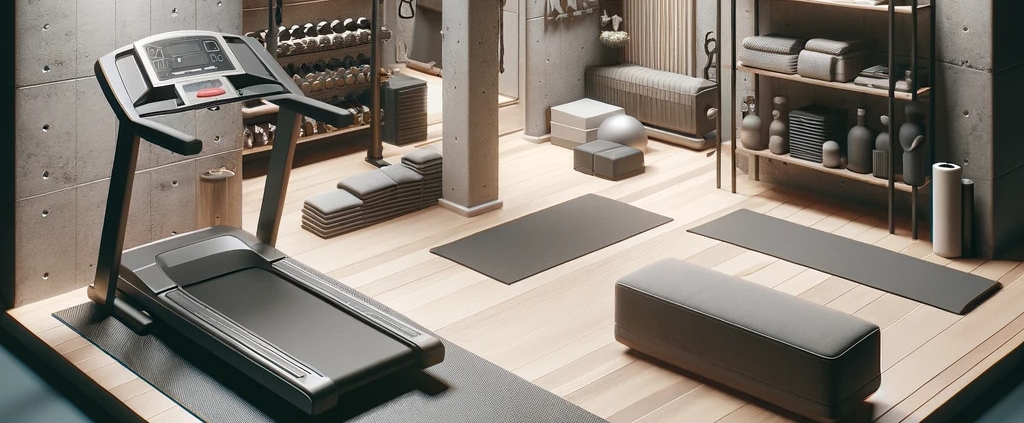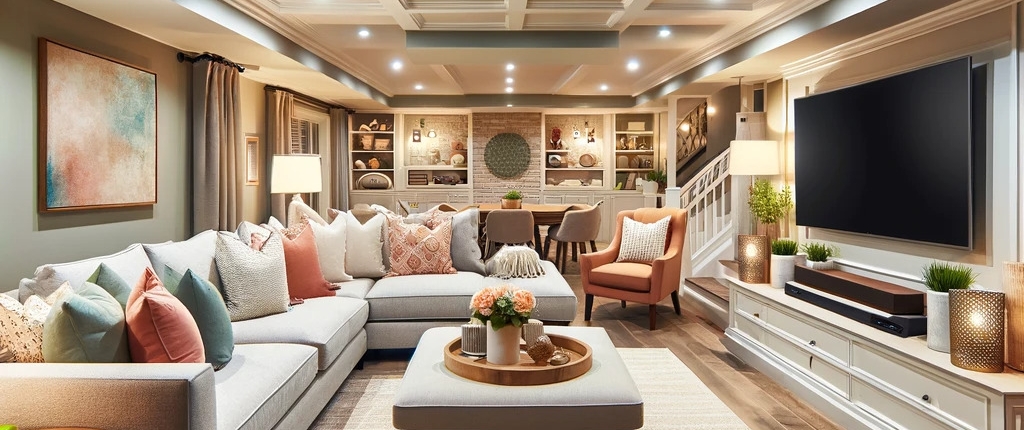What Is Basement Remodeling, Really?
If your basement looks like a garage without the car, you’re not alone. Remodeling it means taking that cold, cluttered space and turning it into something you’ll actually use—like a guest suite, home office, playroom, or gym (that may or may not see real workouts).
A remodel can involve insulation, new walls and flooring, lighting, and finishing touches that make the space feel like it belongs in your home—not under it.
Every remodel is different because every home (and homeowner) is. Whether you want a zen reading nook or a revenue-generating rental unit, your basement can handle it.
Need ideas? Browse our basement renovation design guide or these inspiring reno ideas.
Why Remodel Your Basement?
Here’s why a basement remodel might be the smartest square footage decision you’ll ever make:
- More space. Add living areas without adding an addition.
- More value. Finished basements boost home resale prices.
- More flexibility. Game room, in-law suite, income unit—take your pick.
- More control. You get to design it to fit your life.
- Less waste. Stop wasting hundreds of square feet on storage you never organize.
Just remember: good design is important—but so is waterproofing. One flood and you’ll wish you paid attention to both.
Step 1: Plan Like a Pro
Remodeling a basement starts with a clear plan—because winging it rarely works in construction.
Set Your Goal
What do you actually need? A hangout space? An office? A full suite? Get specific. If you plan it around what you’ll use most, you won’t regret it later.
Tip: Design for the future. A kids’ playroom can easily become a teen lounge or guest room down the road. Need inspo? Try our basement renovation ideas.

Set a Budget
Decide how much you can (and want to) spend. Be realistic—and build in a 10–20% buffer for surprise costs. Because there will be surprise costs.
Here’s a basic template to start with:
| Cost Category | Estimated Cost |
|---|---|
| Materials | $ ($5,000 – $15,000) |
| Labour | $ ( $10,000 – $25,000) |
| Permits | $ ($500 – $2,000) |
| Contingency (10–20%) | $ ($2,000 – $5,000) |
| Total | $ ($17,500 – $47,000+) |
Get a breakdown by project type here: Basement renovation cost
Understand the Scope
Before you grab a sledgehammer, make a list of what needs doing. Will you reframe walls? Add plumbing? Install new lighting? Knowing the scope helps with scheduling, budgeting, and hiring.
Common steps include:
- Framing
- Electrical + plumbing
- Insulation and drywall
- Flooring and painting
- Fixtures, lighting, built-ins
Thinking about extras like a wet bar or home theater? Now’s the time to factor those in.
.
Step 2: Prep Before You Build
Skipping prep is how renos go off the rails. Check your space thoroughly before you start anything.
Evaluate the Condition
Look for signs of water, mold, pests, or structural damage. If you find any, pause the design dreaming and deal with those first. Trust us—covering them up doesn’t make them disappear.
Fix What’s Broken
No one wants to spend thousands remodeling a basement that leaks. Fix the water issues, treat any mold, and patch up cracks or framing problems before moving forward.

Get the Right Permits
Depending on where you live and what you’re doing, permits might be required for:
| Permit Type | What It Covers |
|---|---|
| Building Permit | Layout changes, framing, structural |
| Electrical Permit | New wiring, outlets, panels |
| Plumbing Permit | Bathrooms, laundry, water lines |
In Montreal? Start here: Renovation and construction permits
Step 3: Remodel in Stages
Breaking your remodel into steps makes it way less overwhelming. Here’s how to tackle it without losing your mind (or your weekends).
1. Clear It Out
Empty the space, toss what you don’t need, and deep clean. A clean basement helps you spot issues and gives your contractor a blank canvas.
2. Frame It
Put up walls and define the layout. Whether it’s one open space or multiple rooms, framing is the backbone of the build. Bad framing = future headaches.
3. Rough-In Electrical + Plumbing
Now’s the time to run wires, place outlets, and install water lines. This part is best left to pros—especially if you want to avoid blowing a fuse or flooding the laundry room.
4. Insulate + Drywall
Insulation makes the space livable and energy efficient. Drywall makes it look like an actual room. You’re now past the halfway point—celebrate with snacks.
5. Paint + Flooring
Pick light colours to brighten the space. For floors, go with vinyl plank, tile, or engineered wood. Skip carpet unless you really enjoy mold.
6. Install Fixtures + Finishes
Lights, cabinets, trim, and anything else that makes the room feel finished. This is the fun part—where it all starts to look like you imagined.
More reno advice here: Basement remodeling blog
Tips to Get It Right
Here’s how to make the most of your remodel:

Maximize the Space
- Use an open floor plan if you can
- Go vertical with shelves or storage
- Pick furniture that does double-duty (sofa bed, storage ottoman, etc.)
- Use mirrors to open things up (and to check for surprise workout motivation)
More layout ideas: Basement renovation ideas
Light It Up
Basements are naturally dark—don’t let the lighting be an afterthought.
- Use recessed lighting to save headroom
- Mix ambient and task lighting
- Choose light paint colors and reflective finishes
- Add windows or sun tunnels if possible (and permitted)
Lighting design tips: Renovation design guide
Choose Durable Materials
- Go moisture-resistant with flooring (vinyl, tile)
- Avoid cheap MDF near floors or windows
- Use semi-gloss paint for easy cleanup and water resistance
- If it can survive a spilled juice box or basement hockey game, you’re good
Need a material breakdown? Head to basement renovation cost
Function First
Design is great—but functionality is what keeps you using the space:
- Plan your layout around how you’ll actually use it
- Don’t skimp on comfy seating or noise control
- Add insulation, especially if your HVAC doesn’t quite reach
- Make it easy to access and move around
Wrapping It Up
A basement remodel might seem like a huge task—and sure, it’s not a weekend project—but with a clear plan, smart choices, and the right people helping out, it’s completely doable.
And once it’s done, you’ll wonder why you waited so long to use all that space.
Need help with the first step? Explore:

